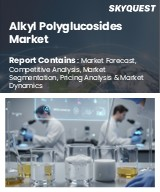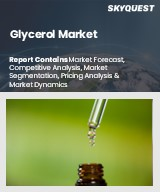
|
시장보고서
상품코드
1771362
세계의 지방족 알코올 시장 수요 및 예측 분석(2018-2034년)Global Fatty Alcohol Market Demand & Forecast Analysis, 2018-2034 |
||||||
세계 지방족 알코올 시장은 여전히 광범위한 화학 및 퍼스널케어 산업에서 중요한 부문입니다. 지방족 알코올은 탄소 사슬의 길이에 따라 단쇄(C6-C10), 중쇄(C11-C14), 장쇄(C15-C22)로 분류되며, 천연 오일, 석유화학제품 또는 기타 원료로부터 얻어지는 다용도 지방 화합물입니다. 이러한 화학물질은 비누 및 세제에서 윤활유와 플라스틱에 이르기까지 많은 생활용품의 기본 성분으로 사용됩니다. 퍼스널케어 제품에 대한 소비자 수요가 증가함에 따라, 특히 클린 라벨과 식물성 성분에 대한 관심이 높아지면서 지방족 알코올은 계속해서 시장을 주도하고 있습니다. 동시에 산업 및 화학 부문에서는 유화제, 화학 중간체 및 성능 첨가제로도 사용됩니다.
지역 수요 분석
아시아태평양은 인도네시아와 말레이시아와 같은 국가에서 팜유와 코코넛 오일의 높은 생산량과 중국 및 인도의 퍼스널케어 수요 증가로 인해 지방족 알코올 시장을 주도하고 있습니다. 이 지역은 또한 급속한 인프라 확장과 소비자 시장의 성장으로 인해 산업 수요에서도 우위를 점하고 있습니다. 북미와 유럽은 강력한 퍼스널케어 산업, 천연 제품 트렌드, 탄탄한 산업 기반 덕분에 큰 시장 점유율을 유지하고 있습니다. 라틴아메리카와 중동 및 아프리카의 신흥 시장은 조달 및 변동성 문제에도 불구하고 성장 기회를 제공합니다. 천연 및 지속 가능한 성분으로 전환하는 전 세계적인 추세는 특히 천연 원료 공급이 풍부한 지역에 유리합니다.
주요 제조업체
지방족 알코올 부문에는 여러 대형 세계 및 지역 제조업체가 있습니다. 주요 제조업체로는 Procter & Gamble과 KAO Corporation이 있으며, 이 회사는 내복용 제제에 알코올을 많이 사용하며, BASF, Sasol, Shell Chemicals, Emery Oleochemical은 주요 상업용 제조업체입니다. International, Godrej, Kuala Lumpur Kepong, Ecogreen, Huaxing, Musim Mas, VVF와 같은 석유화학 기업들은 천연 기반 및 혼합 원료 알코올로 지역 및 국제 시장에 대응하고 있습니다. 이들 기업은 가격, 순도, 사회적 책임, 공급망 투명성, 기술 지원으로 경쟁하고 있습니다.
시장 역학
시장 역학은 두 가지 큰 힘, 즉 퍼스널케어 분야에서 천연 및 지속 가능한 원료로의 전환과 산업 분야에서 효율적이고 비용 효율적인 대체품에 대한 요구라는 두 가지 큰 힘에 의해 움직이고 있습니다. 지속가능성에 대한 노력은 기업들이 천연 알코올을 채택하도록 장려하는 한편, 토지 사용 및 추적 가능성에 대한 우려를 불러일으키고 있습니다. 한편, 원료 가격의 변동(특히 팜유와 석유화학제품)은 마진에 영향을 미칩니다. 환경 영향과 성분의 투명성에 대한 규제의 발전도 공급업체의 전략과 제품 포지셔닝을 형성하는 데 중요한 역할을 하고 있습니다.
시장 성장 촉진요인 : 퍼스널케어의 지속가능성
퍼스널케어 분야에서 환경 친화적인 소비자와 브랜드가 증가하면서 천연 지방족 알코올에 대한 수요가 증가하고 있습니다. 구매자들은 지속 가능한 조달 및 환경 영향 최소화 인증을 받은 원료를 점점 더 선호하고 있습니다. 소비자들이 천연 또는 식물성 뷰티 제품을 찾는 가운데, 제조업체들은 민감한 피부를 위한 포뮬러와 친환경 포장에 적합한 순도가 높은 인증된 지방족 알코올을 제공함으로써 이에 대응하고 있습니다. 이러한 추세는 추적 가능하고 책임감 있게 조달된 원료에 대한 제조업체의 장기적인 투자를 촉진하고 있습니다.
시장 성장 억제요인: 원자재 및 가격 변동성
수요 증가에도 불구하고 지방족 알코올 시장은 여전히 원료 공급과 가격 변동성의 영향을 받기 쉽습니다. 팜유나 야자유와 같은 천연 오일에서 추출한 원료는 지역별 작황, 날씨, 정책 변화에 영향을 받습니다. 합성 루트는 석유 및 가스 시장에 의존하고 있으며, 이 또한 불안정합니다. 이러한 변동은 제품 비용과 공급 능력에 큰 영향을 미칠 수 있으며, 안정적인 공급과 장기적인 가격 책정을 원하는 사용자들의 의욕을 꺾을 수 있습니다. 이러한 리스크를 관리하기 위해서는 정교한 조달 전략, 원료의 다양화, 고부가가치 포지셔닝이 필요합니다.
세계의 지방족 알코올 시장에 대해 조사 분석했으며, 시장 역학 및 산업 동향, 각 부문별 수요 및 공급, 제조업체 프로파일 등의 정보를 전해드립니다.
목차
제1장 서론
제2장 시장 요약
- 시장 발전
- 수급 개요
- 산업 구조
- 전략상 문제
- 최종 용도 동향
- 성장 예측
제3장 경제와 에너지 전망
- GDP와 인구통계
- 금융 정책과 재정 정책
- 원유 생산과 가격
- 천연가스
- 전기요금
제4장 최종 용도 부문 실적
- 퍼스널케어
- 산업
- 화학
- 플라스틱
- 기타
제5장 생산능력(플랜트와 프로젝트) 분석
- 생산능력 : 기업별
- 생산능력 : 국가/지역별
- 생산능력 개요 : 지역/국가별
제6장 지방족 알코올 서론과 시장 개요
- 제품 설명
- 등급과 특성
- 원재료
- 제조 공정
- 환경 문제
- 밸류체인
- 용도
제7장 시장 역학과 산업 동향
- 시장 역학
- 성장 촉진요인
- 성장 억제요인
- 기회
- 과제
제8장 세계의 지방족 알코올 수급 분석 : 유형별, 원재료 유형별, 용도별(수량과 금액)(2018년-2034년)
- 전략상 문제
- 수급 분석과 예측(2018년-2034년)
- 생산능력
- 가동률
- 생산
- 수입
- 수출
- 순수출
- 수요
- 수요 성장률
- 성장 촉진요인 분석
- 세계의 지방족 알코올 시장 : 유형별
- 단쇄(C6-C10)
- 중쇄(C11-C14)
- 장쇄(C15-C22)
- 세계의 지방족 알코올 시장 : 원재료 유형별
- 천연 유지 유래
- 석유 유래
- 석탄 유래
- 기타
- 세계의 지방족 알코올 시장 : 용도별
- 비누 및 세제
- 퍼스널케어
- 아민
- 윤활유
- 화학 중간체
- 플라스틱
- 기타
제9장 수급 분석과 시장 리뷰 : 지역/국가별(수량과 금액)(2018년-2034년)
- 전략상 문제
- 생산능력
- 가동률
- 생산
- 수입
- 수출
- 순수출
- 수요
- 수요 성장률
- 지방족 알코올 시장 : 유형별
- 지방족 알코올 시장 : 원재료 유형별
- 지방족 알코올 시장 : 용도별
- 북미
- 미국
- 캐나다
- 멕시코
- 서유럽
- 독일
- 프랑스
- 이탈리아
- 영국
- 스페인
- 기타 서유럽
- 중유럽 및 동유럽
- 러시아
- 폴란드
- 기타 중유럽 및 동유럽
- 아시아태평양
- 중국
- 일본
- 인도
- 한국
- 기타 아시아태평양
- 중남미
- 중동 및 아프리카
제10장 가격 분석
- 지방족 알코올 평균 가격
- 평균 가격 : 지역별
- 가격 예측
제11장 주요 전략상 문제
제12장 기회 평가
- 시장의 매력 평가
- 전망과 타겟 시장 조사
제13장 전략적 추천과 제안
제14장 기업 분석
- 지방족 알코올 제조업체 개요/기업 분석
- 기본 상세
- 본사 및 주요 시장
- 소유
- 기업 재무
- 제조거점
- 세계의 판매
- 총 직원수
- 제품 포트폴리오/서비스/솔루션
- 채택된 주요 사업 전략과 Prismane Consulting 개요
- 최근 발전
- 대상 기업
- Procter & Gamble
- KAO Corporation
- BASF
- Wilmar International Limited
- Godrej Industries
- Kuala Lampur Kepong Berhad(KLK)
- Sasol
- Emery Oleochemical
- Shell Chemicals
- Ecogreen Oleochemicals
- Huaxing Group
- Musim Mas Holdings
- VVF Limited.
- 기타 제조업체
제15장 부록
LSH 25.07.23The global fatty alcohols market remains a critical segment in the broader chemical and personal care industries. Fatty alcohols-classified by carbon chain length as short (C6-C10), mid-cut (C11-C14), and long (C15-C22)-are versatile fatty compounds derived either from natural oils and fats, petrochemicals, or other sources. These chemicals serve as foundational ingredients in many everyday products, from soaps and detergents to lubricants and plastics. As consumer demand for personal care products grows-especially with interest in clean-label and plant-based formulations-fatty alcohols continue to see strong market pull. At the same time, industrial and chemical sectors rely on them for emulsification, chemical intermediates, and performance additives.
Demand by Type and Raw Material
The varying chain lengths of fatty alcohols cater to distinct functions. Short-chain alcohols, known for their rapid solubility and surfactant performance, are often used in detergents and cleaners. Mid-cut chains strike a balance between cost and performance and are widely used in personal care items like shampoos and creams. Long-chain alcohols are used in heavy-duty applications such as lubricants and plastics as well as high-end cosmetic emulsions.
Raw material source is another critical differentiation. Natural oil-derived fatty alcohols (from palm, coconut, or tallow) are popular in eco-conscious personal care products, while petro- and coal-based alcohols remain cost-competitive. Demand is increasingly shifting toward natural sources due to sustainability concerns, even though cost advantages still make synthetic routes attractive, particularly for industrial applications.
Demand by Application
Soaps & detergents represent traditional and substantial applications for fatty alcohols, leveraging their emulsifying and cleaning properties. The personal care segment-covering shampoos, lotions, and creams-is a growing and lucrative area, driven by rising consumer standards for texture, mildness, and product appeal. Another important category includes amines and chemical intermediates, where fatty alcohols form building blocks for surfactants, corrosion inhibitors, and plasticizers. Other applications such as lubricants, plastics, and specialty chemicals also utilize fatty alcohols for their performance and stability characteristics. Together, these applications underpin a diversified demand profile that supports stable market growth.
Regional Demand Analysis
Asia-Pacific leads the fatty alcohols market, fuelled by high palm and coconut oil production in countries like Indonesia and Malaysia and rising personal care demand in China and India. The region also dominates industrial demand due to rapid infrastructure expansion and growing consumer markets. North America and Europe maintain significant market shares, driven by strong personal care industries, natural product trends, and established industrial bases. Emerging markets in Latin America, the Middle East & Africa offer growth opportunities despite challenges related to sourcing and volatility. The global shift toward natural, sustainable ingredients especially favors regions with abundant natural raw material supplies.
Key Manufacturers
The fatty alcohol sector features several large-scale global and regional manufacturers. Major players include Procter & Gamble and KAO Corporation, which often use alcohols in internal formulations. BASF, Sasol, Shell Chemicals, and Emery Oleochemical are leading commercial producers. Oleochemical companies such as Wilmar International, Godrej, Kuala Lumpur Kepong, Ecogreen, Huaxing, Musim Mas, and VVF cater to regional and international markets with both natural-based and mixed feedstock alcohols. These companies compete on price, purity, social responsibility, supply chain transparency, and technical support.
Market Dynamics
Market dynamics are driven by two major forces: the shift toward natural, sustainable feedstocks in personal care and the need for efficient, cost-effective alternatives in industrial applications. Sustainability initiatives encourage companies to adopt natural alcohols but also raise concerns about land use and traceability. Meanwhile, feedstock price fluctuations-especially for palm oil and petrochemicals-impact margins. Regulatory developments related to environmental impact and ingredient transparency also play a key role in shaping supplier strategies and product positioning.
Market Driver: Sustainability in Personal Care
The rise of eco-conscious consumers and brands in personal care has elevated demand for natural fatty alcohols. Buyers increasingly favor ingredients certified for sustainable sourcing and minimal environmental impact. As consumers seek natural or plant-based beauty products, manufacturers are adapting by offering higher-purity, certified fatty alcohols suitable for sensitive-skin formulations and eco-friendly packaging. This trend encourages long-term investment by producers in traceable, responsibly sourced feedstock.
Market Restraint: Feedstock and Price Volatility
Despite increasing demand, the fatty alcohols market remains susceptible to feedstock supply and pricing volatility. Natural oil-based feedstocks such as palm and coconut oil are influenced by regional crop performance, weather events, and policy changes. Synthetic routes rely on oil and gas markets, which are equally volatile. These fluctuations can profoundly affect product cost and availability and may discourage users who need stable supply and long-term pricing. Managing these risks requires sophisticated procurement strategies, diversification of raw materials, and value-added positioning.
Table of Contents
1. Introduction
- Scope
- Market Coverage
- Types
- Raw Material Types
- Applications
- Regions
- Countries
- Years Considered
- Historical - 2018 - 2023
- Base - 2024
- Forecast Period - 2025 - 2034
- Research Methodology
- Approach
- Research Methodology
- Prismane Consulting Market Models
- Assumptions & Limitations
- Abbreviations & Definitions
- Conversion Factors
- Data Sources
2. Market Synopsis
- Market Evolution
- Demand-Supply Overview
- Industry Structure
- Strategic Issues
- End-use Trends
- Growth Forecast
3. Economic & Energy Outlook
- GDP and Demographics
- Monetary & Fiscal Policies
- Crude Oil Production and prices
- Natural Gas
- Electricity Prices
4. End-use Sector Performance
- Personal Care
- Industrial
- Chemical
- Plastics
- Others
5. Capacity (Plants & Projects) Analysis
- Capacity, by Company
- Capacity, by Country and by Region
- Capacity Overview, By Region and Country
6. Introduction to Fatty Alcohol and Market Overview
- Product Description
- Grades & Properties
- Raw Material
- Manufacturing Process
- Environmental Issues
- Value Chain
- Applications
7. Market Dynamics and Industry Trends
- Market Dynamics
- Drivers
- Restraints
- Opportunities
- Challenges
8. Global Fatty Alcohol Demand-Supply Analysis, By Types, By Raw Material Types, By Applications (Volume, Value) (2018-2034)
- Strategic Issues
- Demand-Supply Analysis and Forecast (2018- 2034)
- Capacity
- Capacity Utilization (%)
- Production
- Imports
- Exports
- Net Trade
- Demand
- Demand Growth Rate (%)
- Driving Force Analysis
- Global Fatty Alcohol Market, By Types
- Short Chain (C6-C10)
- Midcut Chain (C11-C14)
- Long Chain (C15-C22)
- Global Fatty Alcohol Market, By Raw Material Types
- Natural Oils & Fat Based
- Petro-Based
- Coal Based
- Others
- Global Fatty Alcohol Market, By Applications
- Soap & Detergents
- Personal Care
- Amines
- Lubricants
- Chemical Intermediate
- Plastics
- Others
9. Demand-Supply Analysis and Market Review, By Region, By Country (Volume, Value), (2018- 2034)
- Strategic Issues
- Capacity
- Capacity Utilization (%)
- Production
- Imports
- Exports
- Net Exports
- Demand
- Demand Growth Rate (%)
- Fatty Alcohol Market, By Types
- Fatty Alcohol Market, By Raw Material Types
- Fatty Alcohol Market, By Applications
Note: Demand-Supply Analysis has been provided for all major Regions / Countries as mentioned below. The demand (consumption) split by types, raw material types, by applications has been provided for each of the countries/regions in Volume (Kilo tons) and Value (USD Million).
- North America
- USA
- Canada
- Mexico
- Western Europe
- Germany
- France
- Italy
- United Kingdom
- Spain
- Rest of Western Europe
- Central & Eastern Europe
- Russia
- Poland
- Rest of Central & Eastern Europe
- Asia-Pacific
- China
- Japan
- India
- South Korea
- Rest of Asia-Pacific
- Central & South America
- Middle East & Africa
Note: CAGR will be calculated for all types, raw material types and applications to arrive at the regional / global Demand-Supply growth for the forecast period (2025 - 2034)
10. Pricing Analysis
- Average Fatty Alcohol Prices, USD/Kg
- Average prices, by region
- Price Forecast
11. Key Strategic Issues
12. Business Opportunity Assessment
- Market Attractiveness Assessment
- Prospective & Target Market Study
13. Strategic Recommendation & Suggestions
14. Company Analysis
- Fatty Alcohol Manufacturers Profiles/ Company Analysis
- Basic Details
- Headquarter, Key Markets
- Ownership
- Company Financial
- Manufacturing Bases
- Global Turnover
- Total Employee
- Product Portfolio / Services / Solutions
- Key Business Strategies adopted and Prismane Consulting Overview
- Recent Developments
- Companies Covered -
- Procter & Gamble
- KAO Corporation
- BASF
- Wilmar International Limited
- Godrej Industries
- Kuala Lampur Kepong Berhad (KLK)
- Sasol
- Emery Oleochemical
- Shell Chemicals
- Ecogreen Oleochemicals
- Huaxing Group
- Musim Mas Holdings
- VVF Limited.
- Other Manufacturers
Note: This section includes company information, company financials, manufacturing bases and operating regions. Company financials have been mentioned only for those companies where financials were available in SEC Filings, annual reports, or company websites. All the reported financials in this report are in U.S. Dollars. Financials reported in other currencies have been converted using average currency conversion rates. Company profiles may include manufacturers, suppliers, and distributors.
15. Appendices
- Demand-Supply - Regions
- Demand-Supply - Countries
- Capacities, 2018-2034



















